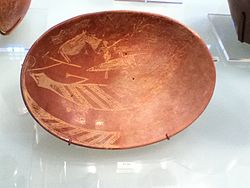Early Dynastic Period (Egypt): Difference between revisions
No edit summary |
m →External links: added external link |
||
| Line 29: | Line 29: | ||
==External links== |
==External links== |
||
*[http://www.reshafim.org.il/ad/egypt/narmer/ Narmer Palette] |
*[http://www.reshafim.org.il/ad/egypt/narmer/ Narmer Palette] |
||
*[http://www.ancientegyptonline.co.uk/earlydyn.html Early Dynastic Period] |
|||
[[Category:Dynasties of ancient Egypt]] |
[[Category:Dynasties of ancient Egypt]] |
||
Revision as of 14:34, 16 May 2011
This February 2010 needs additional citations for verification. (February 2010) |
| ||
| tȝwy 'Two Lands' in hieroglyphs | ||
|---|---|---|

| History of Egypt |
|---|
 |
|
|
| Periods and dynasties of ancient Egypt |
|---|
|
All years are BC |
The Archaic or Early Dynastic Period of Egypt immediately follows the unification of Lower and Upper Egypt c. 3100 BC. It is generally taken to include the First and Second Dynasties, lasting from the Protodynastic Period of Egypt until about 2686 BC, or the beginning of the Old Kingdom.[1] With the First Dynasty, the capital moved from Abydos to Memphis with a unified Egypt ruled by an Egyptian god-king. Abydos remained the major holy land in the south. The hallmarks of ancient Egyptian civilization, such as art, architecture and many aspects of religion, took shape during the Early Dynastic period.
Before the unification of Egypt, the land was settled with autonomous villages. With the early dynasties, and for much of Egypt's history thereafter, the country came to be known as the Two Lands. The rulers established a national administration and appointed royal governors. The buildings of the central government were typically open-air temples constructed of wood or sandstone. The earliest hieroglyphs appear just before this period, though little is known of the spoken language they represent.
In about 3600 BC, Egyptian society along the Nile River began to grow and advance rapidly toward civilization.[2] A new and distinctive pottery, which was related to the pottery of the Southern Levant, appeared during this time. Extensive use of copper became common during this time.[2] The Mesopotamian process of sun-dried bricks, and architectural building principles--including the use of arch and of recessed walls for decorative effect--became popular during this time.[2]
Concurrent with these cultural advances, a process of unification of the societies and towns of the upper Nile River, or Upper Egypt, occurred. Upper Egypt was symbolized by the lotus flower. At the same time the societies of the Nile Delta, or Lower Egypt also under went a unification process.[2] The symbol of Lower Egypt was the papyrus reed. Warfare between Upper and Lower Egypt occurred often.[2] During his reign in Upper Egypt, King Narmer defeated his enemies on the Delta and merged both the Kingdom of Upper and Lower Egypt under his single rule. Narmar is shown on palettes a wearing the double crown, composed of the lotus flower and the papyrus reed - a sign of the unified rule of both parts of Egypt which was followed by all succeeding rulers.
According to Manetho, the first king of the unified Upper and Lower Egypt was Menes. However, the name "Menes" and the name "Narmer" may refer to the same person.[2] The earliest recorded king of the First Dynasty was Hor-Aha, and the first king to claim to have united the two lands was Narmer (the final king of the Protodynastic Period). His name is known because it is written on a votive palette used for grinding minerals for kohl, used by ancient Egyptians to outline the eyes.[2]
Funeral practices for the peasants would have been the same as in predynastic times, but the rich demanded something more. Thus, the Egyptians began construction of the mastabas which became models for the later Old Kingdom constructions such as the Step pyramid. Cereal agriculture and centralization contributed to the success of the state for the next 800 years.
It seems certain that Egypt became unified as a cultural and economic domain long before its first king ascended to the throne in the lower Egyptian city of Memphis where the dynastic period did originate. Political unification proceeded gradually, perhaps over a period of a century or so as local districts established trading networks and the ability of their governments to organize agriculture labor on a larger scale increased, divine kingship may also have gained spiritual momentum as the cults of gods like Horus, Set and Neith associated with living representatives became widespread in the country.[3]
References
- ^ Shaw, Ian, ed. (2000). The Oxford History of Ancient Egypt. Oxford University Press. p. 479. ISBN 0-19-815034-2.
- ^ a b c d e f g Carl Roebuck, The World of Ancient Times (Charles Scribner's Sons: New York, 1966) p. 52-53.
- ^ The Penguin Historical Atlas of Ancient Egypt pg 22-23 (1997) By Bill Manley
Further reading
- Shaw, Ian (2003). The Oxford History of Ancient Egypt. UK: Oxford University Press. ISBN 9780192804587.
- Wilkison, Toby (2001). Early Dynastic Egypt: Strategies, Society and Security. New York: Routledge. ISBN 0415260116.
- Wengrow, David (2006). The Archaeology of Early Egypt: Social Transformations in North-East Africa, c. 10,000 to 2,650 BC. New York: Cambridge University Press. ISBN 0521835860.
